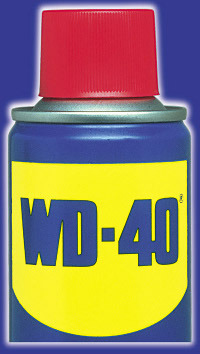What Does WD 40 Stand For?
WD 40 is a clever name for a waterproofing solution. WD-40 literally means “Water Displacement 40th attempt.” It contains hydrocarbons which propel the oils to prevent the wetness of water from reaching the coated surfaces. It has numerous uses as a household tool and is currently available worldwide. The hydrocarbons were then replaced with carbon dioxides as a safety measure later on. The company has been in business ever since 1958 when WD 40 was invented. It was originally designed to coat the SM-65 Atlas Missile to prevent rusting and corrosion from the salt rich air.
What is in the WD 40 Formula?
The exact formula of WD 40 is a trade secret. They wish to protect it to prevent other companies from monetizing knockoff products. This is a very important reason why the recipe is shortened to a few general ingredients. They are required to tell consumers the following list of ingredients due to the government regulations they must follow:
- It contains 50 percent Stoddard Solvents
- 25 Percent Liquefied Petroleum Gas
- A 15+ Percent of Mineral Oils
- ~10 Percent of Inert Materials
The list of ingredients does not give much to work on but it does allow us to understand the toxicity and dangers of the WD 40. For instance, the gaseous oil mixture can enter the lungs if swallowed and cause chemical pneumonitis. The chemical properties of WD 40 make it flammable and volatile, which make it a fire hazard. Coating surfaces like the floor can be extremely dangerous and slippery. The chemicals and oils can also kill plants and irritate/kill animals if not careful.
The Generic Uses for WD 40
WD 40 has many generic uses that make it a versatile tool. The many different categories for use make it valuable as a tool to keep in reach whenever something occurs that can use the WD 40 formula. The following can be done with WD 40:
Petroleum dissolves other oils such as those found in scuffs, crayons, mascara mess on the floor, sticky oil based residues in different locations and more.
Lubrication of items is possible because of the high quality oils in the product. The lubrication of screws, hinges, nuts, bolts, rusty items, lawnmower motors and much more is possible.
Removal of rust is possible with the use of WD 40. Oils bond with the oxygen and metal in rust and wipe away the old layers while restoring shine to the exposed layers of the metals. This is perfect for pipes, keys, hinges, hole punch devices and more.
Gum removal is one of the major uses of WD 40. Gum gets stuck in carpets when shoes drag it indoors. The WD 40 helps to lubricate the fibers of the carpet and keeps the rubber in the gum from sticking worse. The easy removal of the gum just requires some working it out of the carpet and cleaning the area to prevent slipping on the carpet.


Comments - No Responses to “What Does WD 40 Stand For?”
Sorry but comments are closed at this time.